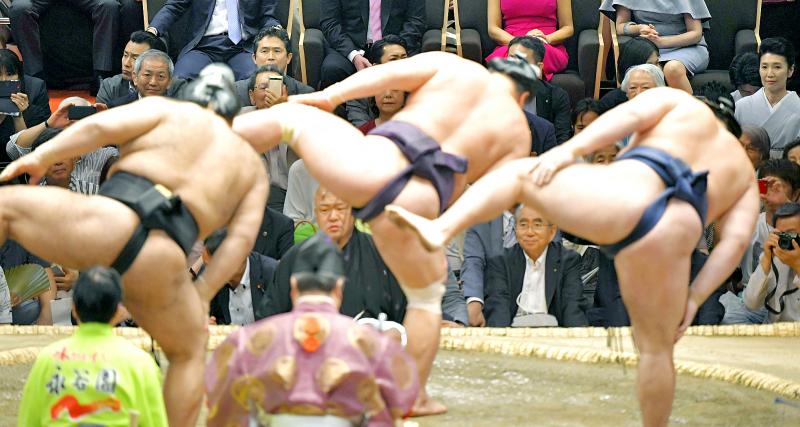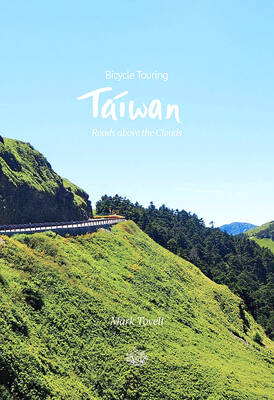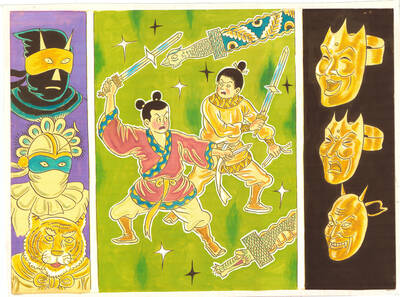Museum curators have engaged in an online battle of the bottoms, assembling on Twitter to present their most captivating behinds, as part of a campaign designed to engage would-be museum visitors who, with many galleries closed because of the coronavirus pandemic, cannot ogle the buns in person.
The #CuratorBattle began in April, but it was last month’s theme, #BestMuseumBum, that has had people enthralled for weeks.
Soon, artworks emerged based on creatures not commonly associated with having bottoms, such as blowflies, mushrooms and fish and categories blossomed to include: bee bottoms, Tudor bums, angular side bum, divine booty, tessellated maenad posteriors, weaponized bum, spectacularly tattooed behind and potato-shaped animal butts.

Photo: AP
The Yorkshire museum launched a #CuratorBattle in April. In the competition’s first round, the museum asked other collections to share the creepiest items. A spokesman explained to the Express and Star newspaper that the #CuratorBattles are also, “a chance for museums big and small to share their objects under a given theme to create what essentially become global online exhibitions.”
In the months since the campaign started, themes have included “fantastic fakes,” “mystery objects” and, somewhat underwhelmingly, “tremendous transport.”
But for those suitably behind the times, #BestMuseumBum had the most to offer. For example, the French word for buttocks, English-speaking readers learned, is “popotins.”
There was the bottom of a stuffed tapir gone bald from too much petting, 3,500-year-old underpants, and “Henry VII’s burgeoning derriere” a collection of his combat armour that grew by almost 20 inches in 20 years: The competition provoked responses from around the world, from Canada to Lithuania. In Japan, the Ota Memorial Museum of Art joined in with some sumo bums painted by Hokusai, while the Netherlands’ Freedom Museum shared an “anti-Hitler pin cushion” and the National Motor Museum in Hampshire, UK, shared a glass car mascot that prompted Northampton’s National Leather Collection to comment “dat (gl)ass.”
Not wanting to be left behind, the Museum of Oxford shared what it called a “shiny flattened peach:” the derriere of a sculpture worn down from people touching it.
When one user asked if the object could be restored, the museum was quick to clarify that the “wearing down of the bum,” was caused during its time on display in the home of Alderman Fletcher, not from recent visitors.
This week’s #CuratorBattle theme, “star objects,” devoted to the most famous pieces in museum collections, will also be the Yorkshire museum’s last, it announced late on Tuesday.

In late October of 1873 the government of Japan decided against sending a military expedition to Korea to force that nation to open trade relations. Across the government supporters of the expedition resigned immediately. The spectacle of revolt by disaffected samurai began to loom over Japanese politics. In January of 1874 disaffected samurai attacked a senior minister in Tokyo. A month later, a group of pro-Korea expedition and anti-foreign elements from Saga prefecture in Kyushu revolted, driven in part by high food prices stemming from poor harvests. Their leader, according to Edward Drea’s classic Japan’s Imperial Army, was a samurai

The following three paragraphs are just some of what the local Chinese-language press is reporting on breathlessly and following every twist and turn with the eagerness of a soap opera fan. For many English-language readers, it probably comes across as incomprehensibly opaque, so bear with me briefly dear reader: To the surprise of many, former pop singer and Democratic Progressive Party (DPP) ex-lawmaker Yu Tien (余天) of the Taiwan Normal Country Promotion Association (TNCPA) at the last minute dropped out of the running for committee chair of the DPP’s New Taipei City chapter, paving the way for DPP legislator Su

It’s hard to know where to begin with Mark Tovell’s Taiwan: Roads Above the Clouds. Having published a travelogue myself, as well as having contributed to several guidebooks, at first glance Tovell’s book appears to inhabit a middle ground — the kind of hard-to-sell nowheresville publishers detest. Leaf through the pages and you’ll find them suffuse with the purple prose best associated with travel literature: “When the sun is low on a warm, clear morning, and with the heat already rising, we stand at the riverside bike path leading south from Sanxia’s old cobble streets.” Hardly the stuff of your

April 22 to April 28 The true identity of the mastermind behind the Demon Gang (魔鬼黨) was undoubtedly on the minds of countless schoolchildren in late 1958. In the days leading up to the big reveal, more than 10,000 guesses were sent to Ta Hwa Publishing Co (大華文化社) for a chance to win prizes. The smash success of the comic series Great Battle Against the Demon Gang (大戰魔鬼黨) came as a surprise to author Yeh Hung-chia (葉宏甲), who had long given up on his dream after being jailed for 10 months in 1947 over political cartoons. Protagonist